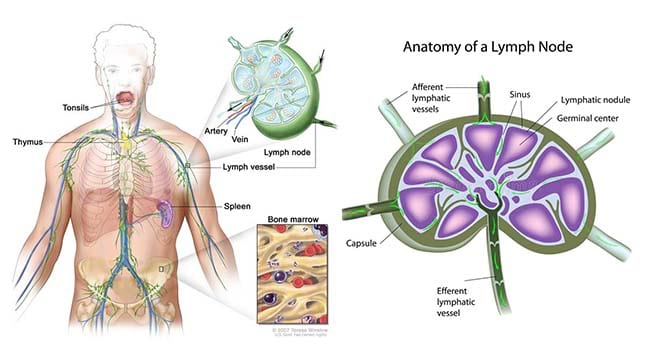- Lymph nodes are small solid structures placed at varying points along the lymphatic system such as the groin, armpit and mesentery.
- They contain both T and B lymphocytes as well as accessory cells and are primarily responsible for mounting immune responses against foreign antigens entering the tissues.
- Lymph nodes are situated at strategic positions throughout the body and serve to filter the lymph.

Interesting Science Videos
Structure of Lymph Nodes
- They range in size from 2 to 10 mm, are spherical in shape and are encapsulated.
- Lymph node is surrounded by a fibrous capsule which dips down into the node substance forming partition or trabeculae.
- The node is made by reticular and lymphatic tissues containing mainly lymphocytes and macrophages.
- Beneath the capsule is the subcapsular sinus, the cortex, a paracortical region and a medulla.
- The cortex contains many follicles and on antigenic stimulation becomes enlarged with germinal centers.
- The follicles are comprised mainly of B cells and follicular dendritic cells.
- The paracortical (thymus-dependent) region contains large numbers of T cells interspersed with interdigitating cells.
- Each lymph node has 4-5 afferent vessels that bring lymph to the node while only one efferent vessel draining lymph away from the node.
- It also has a concave surface called the hilum where an artery enters, a vein and the efferent lymph vessel leave.
- Depending upon the position, the lymph nodes may be superficial or deep lymph nodes. Groups of lymph nodes are present in the neck, collarbone, under the arms (armpit), and groin.
Lymph Circulation in Lymph Nodes
- Lymph arriving from the tissues or from a preceding lymph node in the chain, passes via the afferent lymphatics into the subcapsular sinus and then into the cortex, around the follicles, into the paracortical area and then into the medulla.
- Lymph in the medullary sinuses then drains into efferent lymphatics and hence through larger lymphatic vessels back into the bloodstream.
Functions of Lymph Nodes
- The primary role of the lymph node is to filter the lymph and then produce an immune response against trapped microbes/antigens.
- Filtering of the lymph helps in removal of particles not normally found in the serum.
- The lymphoide tissues in the nodes break down materials which have been filtered off such as microorganisms, tumor cells and cells damaged by inflammation.
- Lymphocyte develops from the reticular and lymphoid tissue in the nodes.
- Antibodies and antitoxins are also formed by the cells of lymph nodes.
References
- Lydyard, P.M., Whelan,A.,& Fanger,M.W. (2005).Immunology (2 ed.).London: BIOS Scientific Publishers.
- Playfair, J., & Chain, B. (2001). Immunology at a Glance. London: Blackwell Publishing.
- Tuitui, R., & Suwal, D. S. (2010). Human Anatomy and Physiology. Kathmandu: Vidyarthi Prakashan.

I enjoy reading through an article that can make people think. Also, thank you for permitting me to comment.